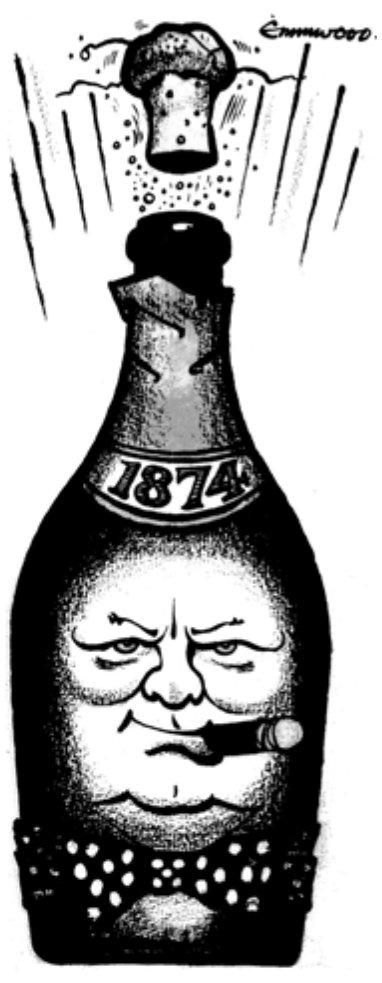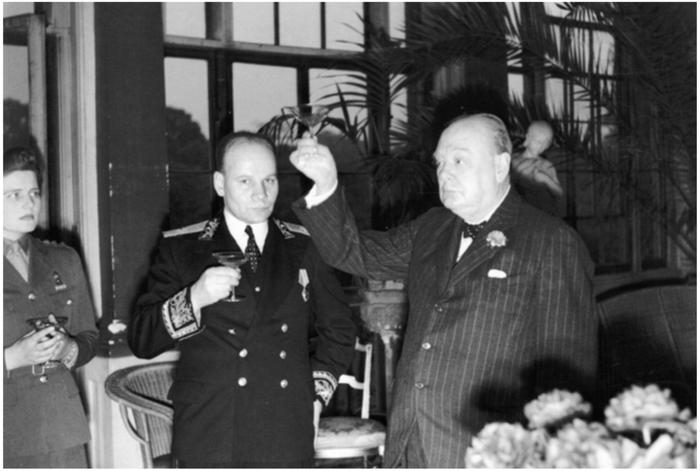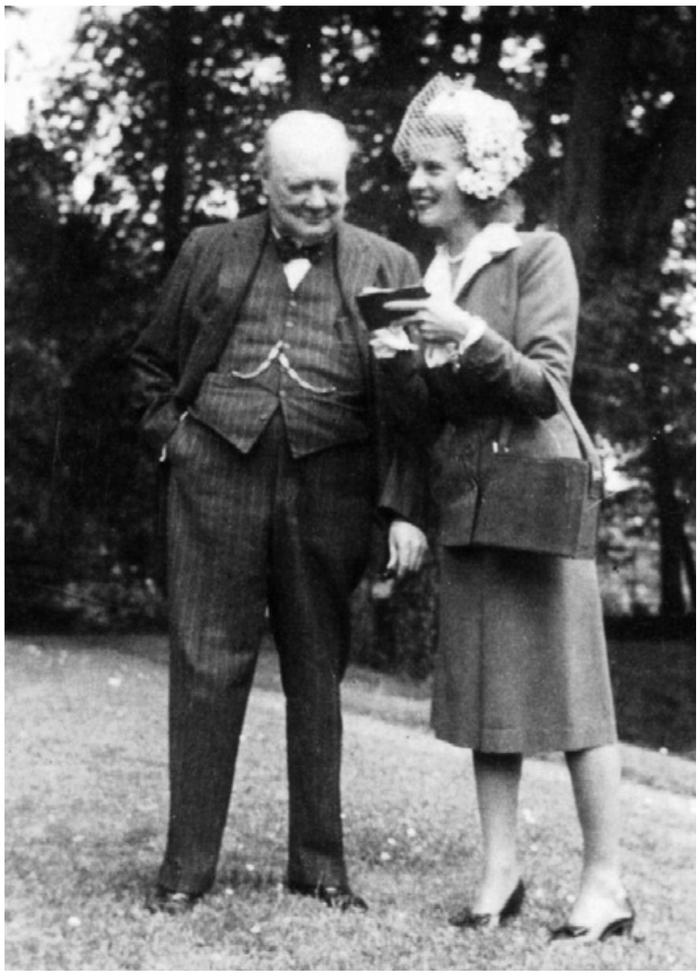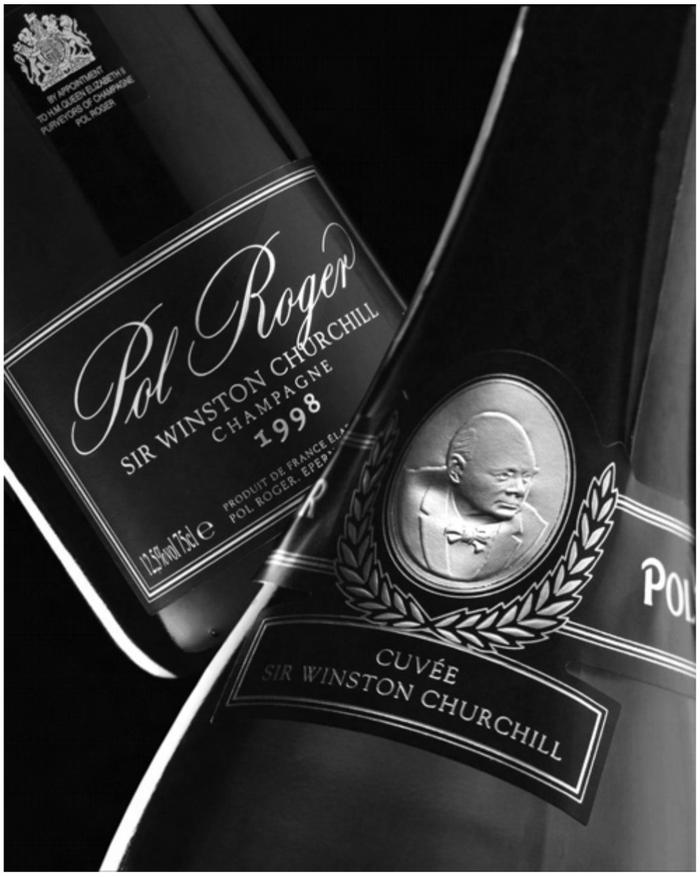Dinner With Churchill: Policy-Making at the Dinner Table (21 page)
Read Dinner With Churchill: Policy-Making at the Dinner Table Online
Authors: Cita Stelzer
Tags: #General, #Biography & Autobiography, #Military, #History, #World War II, #20th Century, #Europe, #World, #International Relations, #Historical, #Political Science, #Great Britain, #Modern, #Cooking, #Entertaining

Set aside self-interested tales of contemporaries, the American tendency to judge Churchill’s consumption by the standards of their own country’s customs and the rather romantic view Churchill seems to have had of himself as a
prodigious consumer of alcohol, and consider the reports of the many people who observed his habits close up. There is agreement on several points:
- He had no use for cocktails, pre-dinner or otherwise. Churchill disliked mixed drinks of the sort that appealed to many Americans. After a meeting with Roosevelt and their military staffs at Quebec in August 1943, Churchill joined Roosevelt and several others at Treasury Secretary Henry Morgenthau’s Fishkill Farms estate. Morgenthau’s son, Robert, mixed mint juleps. “Knowing of Churchill’s intemperance, he was surprised when the Prime Minister had just one.”
32
It is likely that any inclination the Prime Minister had for a second round disappeared with the taste of a mint julep, not the sort of drink on which he had been reared. Indeed, years later, when celebrating Christmas with, among others, one of his secretaries, Jo Sturdee, he snatched from her hand a “fiery cocktail which knocked me back at the first gulp”, and advised her: “No, no, if you want to get drunk, do get drunk on something decent,” and “then got down to champagne”.
33
In spite of this, Joe Gilmour, head barman at the Savoy Hotel from 1940 to 1976, is said to have invented a Blenheim cocktail – also known as the four score and ten – in honour of Churchill’s 90th birthday. It consisted of 3 parts brandy, 2 parts yellow Chartreuse, 1 part Lillet, 1 part orange juice, and 1 part Dubonnet.
34
- He drank Johnnie Walker Black Label – some sources say Red – which, interestingly, is a blend, not a single
malt. In 1946, Berry Brothers apologised for the fact that Churchill’s requested Johnnie Walker Black Label was
unavailable
and that the Berry’s Best Whisky had proved “not suitable to his palate”, recommending instead Cutty Sark. Berry Brothers refunded the payment for the unacceptable six bottles of the shop’s brand which were returned.
35 - The whisky that seemed to some observers to be
omnipresent
was most often diluted with water or with soda, to the point where “It was really a mouthwash”, Jock Colville told Churchill’s biographer Martin Gilbert. “He used to get frightfully cross if it was too strong.”
36
Colville’s observation is shared by John Peck who told Sir Martin, “The glass of weak whisky … was more a symbol than anything else, and one glass lasted him for hours.”
37
Harry Hopkins, and several others whom I interviewed,
including
Lady Williams, uniformly support the Colville and Peck reports.
38 - At times, when Churchill was feeling “sorry for himself … he had a stiff whisky and soda”, once at a quarter to nine in the morning during a stopover on his journey to the Teheran Conference.
39
Of course, he had crossed
several
time zones so his tummy-time would have told him it was late in the day. - Champagne topped the list of Churchill’s favourite drinks, followed by brandy.
Churchill also had a favourite wine merchant, Randolph Payne in Pall Mall, whose telegraphic address was
LUSCIOUS, PICCY, LONDON
.
40
Some say the favoured
merchant was Hatch Mansfield from whom Churchill did buy wines and spirits. As noted earlier, in 1899, Churchill ordered from Randolph Payne:
6 bottles 1889 Vin d’Ay Sec
18 bottles St. Emilion
6 bottles light port
6 bottles French vermouth
18 bottles Scotch whisky (10 year old)
6 bottles Very Old Eau de Vie landed 1866
12 Rose’s Cordial Lime Juice
6 x 1 dozen cases for same, packing, marking etc.
All to be shipped aboard the SS
Dunottar Castle
to Churchill in South Africa.
41

Pop!
In 1947, Churchill told Odette Pol Roger that 44 Avenue de Champagne, Epernay, is the world’s most
drinkable
address”
42
. Dean Acheson recalled Clementine telling him that the Churchill “always had his own bottle of
champagne
by his place at the table, to be independent of the
vagaries
of butlers”.
43
It is reasonable to assume that the bottle was of the since-discontinued 50 cl size, which Churchill preferred to the 75 cl bottle now commonly sold:
44
“A single glass of champagne,” Churchill wrote in 1898, “imparts a feeling of exhilaration. The nerves are braced: the
imagination
is agreeably stirred; the wits become more nimble.” He quickly added, “A bottle produces the opposite effect”.
45
Lady Halifax’s memoirs describe Churchill at one dinner as “grumpy and remote … But mellowed by champagne and good food he became a different man, and a delightful and amusing companion”.
46
In 1898, just before the battle of Omdurman, Churchill was strolling along the banks of the Nile with his fellow officers. British officers hailed him from gunboats afloat on the river, and asked: “How are you for drinks? We have got everything in the world on board here. Can you catch? And almost immediately a bottle of champagne was thrown from the gunboat to the shore. It fell into the waters of the Nile, but happily where a gracious Providence decreed them to be shallow and the bottom soft. I slipped into the waters up to my knees, and reaching down seized the precious gift.”
47
Every celebratory event in Churchill’s long life was marked with champagne. On 8 May 1945, standing on balconies
both at Buckingham Palace and at the Ministry of Health, he received the appreciative thunderous applause of the British public. Later that night, he told his staff that he would visit the American and Soviet embassies to celebrate VE Day with them. At the Soviet embassy, the champagne did not seem to work its usual magic. The Prime Minister raised a glass of champagne with Ambassador Gusev, Mrs. Gusev and Churchill’s daughter Mary. But they were not a
happy-looking
group, for reasons that were becoming apparent.

A victory toast with the Soviet Ambassador Gusev, May 1945
Not just any champagne would do. Churchill was “one of the world’s most expert connoisseurs of champagne”.
48
He sometimes drank older and stronger vintages or varieties such as the Krug 1920, 1926, and the 1937 that he served at Potsdam. But his favourite of favourites was Pol Roger, either the 1921 vintage, a dozen bottles of which Victor Rothschild provided “from his dwindling stock at
Merton Hall” when Churchill’s supply was exhausted,
49
or his ultimate favourite, the 1928 vintage, a case of which Odette Pol Roger sent him on each of his birthdays until supplies ran out in 1953. “Thereafter she reserved the choicest vintages for him; by 1965 he had only worked his way through the harvest of 1934.”
50

Odette Pol Roger with Churchill
Odette Pol Roger was a clever businesswoman. Smart Parisian tastes “had run towards Pommery and Clicquot”,
51
but she made her brand world famous, helped certainly by Churchill’s favouring it so publicly. It is a mystery how he first became such a fan of Pol Roger. We do know he
had ordered a case of the 1895 vintage when a Cabinet Minister and President of the Board of Trade.
52
It was only years later, in 1944, that he met Odette Pol Roger at the Armistice Day party at the British embassy in Paris,
introduced
by the Ambassador, Duff Cooper. They quickly
became
life-long friends. In return for Madame Pol Roger sending him regular shipments, Churchill sent her a copy of his memoirs inscribed “Cuvee de Reserve. Mise en bouteille au Chateau Chartwell”.
53
He also named one of his racehorses Pol Roger; it won the Black Prince Stakes on 2 June 1953, the very day of Queen Elizabeth II’s coronation.

Commemorative bottle
After Churchill’s death, Mme. Pol Roger ordered that the labels on all bottles of champagne exported to Britain be given a black mourning band, a practice discontinued only in 1990 when the house switched to a blue border to
emphasise
Churchill’s naval connections and “his loyalties to the Senior Service” as First Lord of the Admiralty.
54
Today the only champagne served at receptions at Churchill College, Cambridge, is Pol Roger, still generously being donated by the firm.
As with food – Churchill made do and enjoyed spare fare when circumstances demanded – so with drink. When required to live off the land, Churchill would do so with gusto: witness Sir Alexander Cadogan’s report that at the Yalta Conference the Prime Minister was seen to be drinking “buckets of Caucasian champagne which would undermine the health of any ordinary man”.
55
As for brandy, Churchill believed that “fine old
brandy
is something to be treasured”. He never added water to it – “That is a great crime,” he told his valet, Norman McGowan – and he preferred to pour his own, as he did with the bottle of champagne he kept at his side during meals.
56
After retiring as Prime Minister for the second time in 1955, Churchill enjoyed what his then Private Secretary, Anthony Montague Browne, called his Long Sunset – which
included
annual journeys to the South of France to his beloved Hôtel de Paris in Monte Carlo. An added bonus was that the management of that hotel, who had walled up the cellars in 1940, decided to destroy these “fortifications” in Churchill’s honour – producing a bottle of fine old brandy.
57
This certainly met Churchill’s “nothing but the best” standard. Anthony Montague Browne, who accompanied Churchill during many of his travels during the later years, recalled
that L’Hertier de Jean Fremicourt was then Churchill’s
preferred
brandy.
